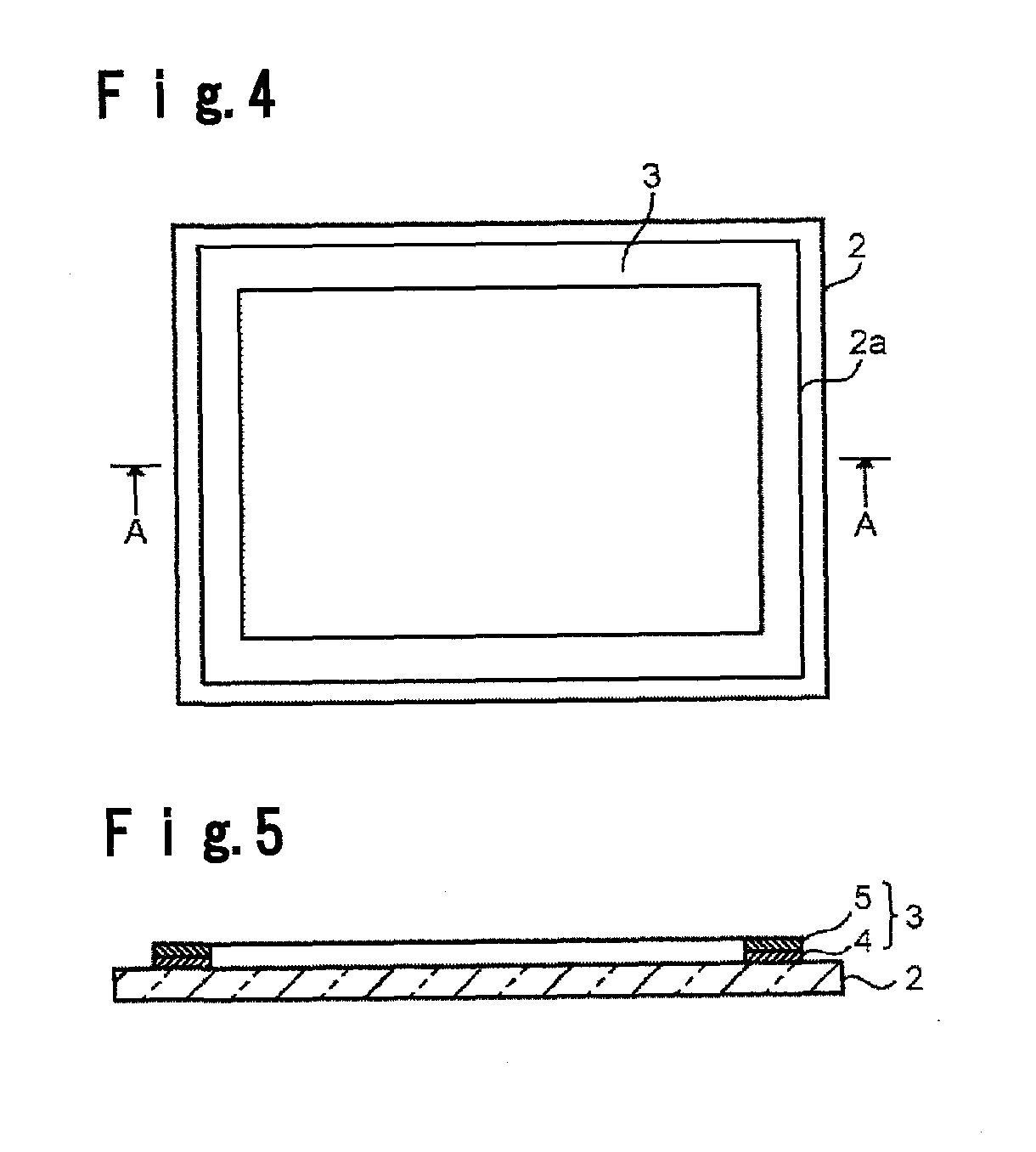Process for producing glass member provided with sealing material layer and process for producing electronic device
a technology of sealing material and glass member, which is applied in the direction of final product manufacturing, sustainable manufacturing/processing, electrolytic capacitors, etc., can solve the problems of cracks, fractures, cracks, and the like on the glass substrate at the time of sealing, and achieve the effect of suppressing cracks, fractures, and separation
- Summary
- Abstract
- Description
- Claims
- Application Information
AI Technical Summary
Benefits of technology
Problems solved by technology
Method used
Image
Examples
example 1
[0059]First, tin-phosphate glass frit (softening point: 401° C.) having a composition comprising, by mass ratio, 63.0% of SnO, 2.0% of SnO2, 29.5% of P2O5, 5.0% of ZnO and 0.5% of SiO2, and having an average particle size of 3 μm, a zirconium phosphate ((ZrO)2P2O7) powder having an average particle size of 3 μm as a low-expansion filler, and a laser absorbent having a composition comprising, by mass ratio, 35% of Fe2O3, 35% of Cr2O3, 20% of CO2O3 and 10% of MnO, and having an average particle size of 2 μm, were prepared. Further, 4 mass % of nitrocellulose as a binder component was dissolved in 96 mass % of a solvent comprising butyl carbitol acetate to prepare a vehicle.
[0060]53 Mass % of the tin-phosphate glass frit and 47 mass % of the zirconium phosphate powder were mixed. The thermal expansion coefficient of the mixture is 45×10−7 / ° C. 80 Mass % of the mixture (first glass material for sealing) of the glass frit with the low-expansion filler was mixed with 20 mass % of the vehi...
example 2
[0064]First and second pastes for a sealing material were prepared in the same manner as in Example 1 except that a zirconium phosphate powder having an average particle size of 7 μm was used as a low-expansion filler and that 100 parts by mass of the mixture of the glass frit with the low-expansion filler was mixed with 2 parts by mass (1.96 mass % to the glass material for sealing) of the laser absorbent for the second glass material for sealing.
[0065]Then, on the outer peripheral region of the same second glass substrate as in Example 1, the first paste for a sealing material was applied by a screen printing method. The first coating layer was subjected to leveling treatment for 5 minutes (standard time) and dried at 150° C. for 5 minutes. Then, in the same manner as in Example 1, the second paste for a sealing material was applied and dried and then fired at 430° C. for 10 minutes to form a sealing material layer. The thickness (after dried) of the first coating layer was 34 μm,...
example 3
[0067]First and second pastes for a sealing material were prepared in the same manner as in Example 1 except that tin-phosphate glass frit having a composition comprising, by mass ratio, 63.3% of SnO, 2.3% of SnO2, 31.2% of P2O5, 3.0% of ZnO and 0.2% of SiO2 was used. The thermal expansion coefficient of a mixture of the tin-phosphate glass frit with the zirconium phosphate powder is 45×10−7 / ° C.
[0068]Then, on the outer peripheral region of the same second glass substrate as in Example 1, the first paste for a sealing material was applied by a screen printing method. The first coating layer was subjected to leveling treatment for 1 minute (standard time) and dried at 150° C. for 5 minutes. Then, in the same manner as in Example 1, the second paste for a sealing material was applied and dried and then fired at 430° C. for 10 minutes to form a sealing material layer. The thickness (after dried) of the first coating layer was 17 μm, and the total thickness (after dried) after applicati...
PUM
| Property | Measurement | Unit |
|---|---|---|
| sealing temperature | aaaaa | aaaaa |
| thickness | aaaaa | aaaaa |
| temperature | aaaaa | aaaaa |
Abstract
Description
Claims
Application Information
 Login to View More
Login to View More - R&D
- Intellectual Property
- Life Sciences
- Materials
- Tech Scout
- Unparalleled Data Quality
- Higher Quality Content
- 60% Fewer Hallucinations
Browse by: Latest US Patents, China's latest patents, Technical Efficacy Thesaurus, Application Domain, Technology Topic, Popular Technical Reports.
© 2025 PatSnap. All rights reserved.Legal|Privacy policy|Modern Slavery Act Transparency Statement|Sitemap|About US| Contact US: help@patsnap.com



